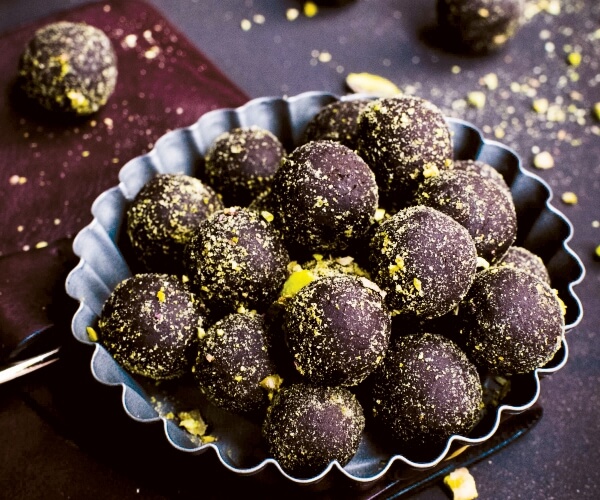I’m quick when it comes to spotting potentially edible foods in the wild; partly from lots of reading about California flora, and how the native peoples provided for themselves; and partly from an all-consuming curiosity that’s been with me since childhood. I like to decipher the connections between plants; what’s related to what; and I’m willing to try almost anything once.
The fruits of the California Bay Tree (Umbellularia californica) looked remarkably like miniature avocado fruits to me, and when I took a small bite from the bottom side of a fresh green bay fruit, I noticed that it also tasted like an under-ripe avocado. Not tasty enough to do anything with, but then I’d been reading that the native peoples harvested the bay fruits to get to the ‘nut’ inside. They also used the bay leaves to treat headaches, toothaches, and earaches, as well as making an infusion with the leaves to use as an antiseptic wash for sores.
Avocados (Persea Americana) and California Bay are closely related: both genera are in the family Lauraceae. Both genera are native to the Americas, and were widely spread in ancient times. The bay is now endemic to the California Floristic Province, extending to the north along the coast to Oregon. In Oregon it’s called Pepperwood, or Peppernut tree, or the Oregon Myrtle; other common names are the headache tree or Mountain Laurel.
The Avocado tree, in ancient times, drifted south, and became a tropical species, while the Bay tree stayed in more temperate zones. The Bay Laurel, a Mediterranean species, also in the Laurel family, is closely related; this is the culinary bay. The tree which gives us Cinnamon is another related species and is native to Asia. It’s the inner bark that is harvested, and as soon as it dries it rolls into a ‘quill; which is what we purchase as cinnamom ‘sticks’. The ‘true’ cinnamon (Cinnamomum zeylanicum) comes from Sri Lanka. Another related species, which is commonly planted as a tree in landscapes and along streets in California is the Camphor tree (Cinnamomum camphoratum).
All these related species have some similar botanical features; leaves are pungent, and if they are set opposite, it’s not quite opposite, but slightly alternate; flowers are small and yellowish, and held in loose umbel-like clusters. The flowering umbels of the bay tree are small (hence the genera name, which means little umbel). The flowers have six petals, and reproductive parts in sets of threes. Flowers are mostly perfect in the California bay, but imperfect in the Bay Laurel.
Plants in the genera Lauraceae produce fruits with a single seed, which most of the time is called a drupe. But in the avocado it is technically a berry, because of the imperceptible endocarp that covers the seed: In the Bay the fruit is a ‘proper drupe’ because the nut is covered in a thin, hard shell.
The California Bay tree blooms in early spring, and sets fruits during the summer. By about late September or early October yellow-green fruits start to drop from the trees. They are easy to spot at this stage, and since I’m always sort of ‘on the lookout’ for foraging opportunities, I’m not above stopping on the soft shoulder of country roads to do some collecting.
But, I collect only when I know there is plenty for the squirrels; they have a neat way of opening a “cap” in the top of the fruit and extracting the nut. This year there were so many, that lots of the nuts were simply crushed on the roads or underfoot along the trails. The fruits continue to drop for two or three months and if not taken by the squirrels (I don’t think many other animals eat them) the fruits start to turn blackish and withered. This doesn’t affect the nut meat adversely, it just makes them harder to see for collection, and it’s a bit harder to remove the fruit from the nut.
If it’s easy to remove the flesh, do so; if not, the fruits can be soaked in water first until the fruit meat is softer and peels off more easily. Crack the hard shell, and remove the nut meats from the shell. They split in half (just like an avocado pit) and are quite oily. They don’t taste good when raw, but when roasted they have a really nice flavor that is somewhere between chocolate and coffee!
When I came up with my recipe for bay nut truffles I was thinking of connections, and that’s why I chose to flavor the cream with cinnamon sticks, and roll the truffles in cocoa combined with cinnamon powder.
I’m starting here with the basic chocolate truffle recipe, and then suggesting some options: But cooking is often a very creative process – and there are always lots of choices – so have fun, and be creative!
THE BASIC GANACHE
- 8 oz. chocolate
- 4 oz. (app.) heavy whipping cream
The Chocolate: Get the highest cocoa content that you can. Trader’s Joe’s carries a ‘pound plus’ bar that is 72% cocoa dark chocolate and chocolate chunks that are 60% cocoa. You can also use chocolate chips. Guittard’s makes a 46% semi-sweet and a 63% bittersweet. Use half each of semi-sweet and bittersweet.
The best way to melt the chocolate is in a double boiler, which allows you to keep it melted while you add and blend the other ingredients. Or melt the chocolate in a the oven at about 200 degrees. You could melt it in a microwave, but with this method you have to act really fast to incorporate the other ingredients while the chocolate is still melted.
The Cream: The first ingredient to add is a portion of the warm heavy cream; if you’re going to flavor the cream add the flavoring and heat the cream just until a ‘skin’ forms. I like to bring the cream to a simmer several times, especially if the flavoring is whole spices, and then let it cool in between.
Slowly stir the warm cream into the melted chocolate and also add flavorings such as various jams, jellies, ground nuts, liqueurs or extracts. Mix it all together to a smooth, even consistency.
Cover it and let the truffle mixture cool at room temperature for at least eight hours – when you’re ready to shape the truffles refrigerate the mixture for about and hour or so.
Spoon out chunks of the truffle mix and roll it into balls in your hands. Work quickly as the mixture melts a bit, then roll the balls in a topping and refrigerate overnight before packaging into paper candy cups.
IDEAS for FLAVORINGS
- Spices – cinnamon sticks, whole cardamom pods, whole cloves
- Extracts – almond, vanilla, coffee
- Liqueurs – Kahlua, Amaretto, Brandy or Sherry
- Nuts – CA. bay nuts, hazel, almond or walnuts – ground to a medium ‘nut meal’ consistency – I use a small food processor to grind the nuts
- Green Herbs such as Mint leaves – these need to be strained out of the cream after the flavor is extracted
IDEAS for TRUFFLE COATINGS
Unsweetened cocoa powder is traditional – this could be mixed with a coarse sugar – like Turbinado, or a fine powdered sugar – or even sea salt – or add in some ground spices – like cinnamon, nutmeg, cardamom, cloves – perhaps even something spicy like cayenne or a masala mix?
Truffles can also be coated with coarsely ground nuts or a nut meal.
CALIFORNIA TRUFFLES
Bay-nut Truffles
Roast the nut meats at about 350 degrees, stirring often – and monitoring to avoid burning – this takes about 30 to 45 minutes –
The nut meats should be about the color of milk chocolate – with some approaching the color of a coffeebean –
- 12 oz chocolate
- 6 oz. heavy cream – flavored with 3 cinnamon sticks
- 5 oz. ground, roasted bay nuts
- 5 to 7 Tbsp. Kahlua
Roll the truffle ‘balls’ in a mixture of ground, roasted Bay nuts, cocoa powder, cinnamon powder, and turbinado sugar – or just cocoa powder and sugar –
Elderberry Truffles
- 12 oz. chocolate
- 6 oz. heavy cream – flavored with 11 cloves
- 3 – 5 Tbsp. Elderberry jelly
Coat the truffles with cocoa powder mixed with sugar and ground cloves
Huckleberry Truffles
- 8 oz. chocolate
- 4 oz. heavy cream – flavored with 5 cardamon pods
- 3 – 5 Tbsp. Huckleberry jam
Coat the truffles with cocoa mixed with sugar and cardamom powder
California Currant Truffles
- 8 oz. chocolate
- 4 oz. heavy cream flavored with cinnamon
- 3 to 5 Tbsp. jelly made from Ribes sanguineum
Coat the truffles with a mix of cocoa, sugar, and cinnamon powder
Rose-hip Truffles
- 8 oz. chocolate
- 4 oz. heavy cream – flavored with 5 cardamon pods
- 2 oz. Rose-hip jam
Coat the truffles with almond meal mixed with sugar
Feel free to adjust the specific proportions– according to taste and also to achieve a consistency that is soft enough to roll, but not so soft that the roll can’t retain its shape –


